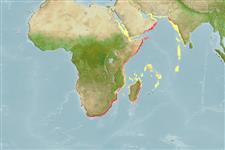Klassifizierung / Names
Namen | Synonyme | Catalog of Fishes(Gattung, Arten) | ITIS | CoL | WoRMS | Cloffa
>
Eupercaria/misc (Various families in series Eupercaria) >
Sparidae (Porgies)
Etymology: Diplodus: Greek, diploos = twice + Greek, odous = teeth (Ref. 45335).
Environment: milieu / climate zone / depth range / distribution range
Ökologie
seewasser riff-verbunden; tiefenbereich 0 - 50 m (Ref. 27121). Tropical; - 35°S
Southeast Atlantic and Western Indian Ocean: Angola to Mozambique and southern Madagascar, possibly reaching Mauritius (Ref. 3168, 3198).
Length at first maturity / Size / Gewicht / Alter
Maturity: Lm 21.1 range ? - ? cm
Max length : 45.0 cm TL Männchen/unbestimmt; (Ref. 3198); common length : 30.0 cm TL Männchen/unbestimmt; (Ref. 3507); max. veröff. Alter: 21 Jahre (Ref. 26244)
Rückenflossenstacheln (insgesamt) : 12; Rückenflossenweichstrahlen (insgesamt) : 14 - 15; Afterflossenstacheln: 3; Afterflossenweichstrahlen: 13 - 14. Young specimens with fine crossbars; large adults almost uniformly black.
Adults occur in shallow rocky and sandy substrate; juveniles in shallow reefs, estuary mouths and intertidal pools, sandy beach surf zone. Omnivorous on seaweeds, sponges and bivalves. Also feeds on crustaceans, worms, mollusks, and fish. Sold fresh or whole and as bait.
Life cycle and mating behavior
Maturities | Fortpflanzung | Spawnings | Egg(s) | Fecundities | Larven
Bauchot, M.-L. and J.-C. Hureau, 1990. Sparidae. p. 790-812. In J.C. Quero, J.C. Hureau, C. Karrer, A. Post and L. Saldanha (eds.) Check-list of the fishes of the eastern tropical Atlantic (CLOFETA). JNICT, Lisbon; SEI, Paris; and UNESCO, Paris. Vol. 2. (Ref. 3688)
IUCN Rote Liste Status (Ref. 130435)
Bedrohung für Menschen
Harmless
Nutzung durch Menschen
Fischereien: weniger kommerziell; Sportfisch: ja; Köder: usually
Tools
Zusatzinformationen
Download XML
Internet Quellen
Estimates based on models
Preferred temperature (Ref.
123201): 18.6 - 27, mean 25.9 °C (based on 56 cells).
Phylogenetic diversity index (Ref.
82804): PD
50 = 0.5000 [Uniqueness, from 0.5 = low to 2.0 = high].
Bayesian length-weight: a=0.01514 (0.00951 - 0.02409), b=3.08 (2.95 - 3.21), in cm total length, based on LWR estimates for this species & Genus-body shape (Ref.
93245).
Trophic level (Ref.
69278): 2.7 ±0.15 se; based on food items.
Generation time: 7.7 ( na - na) years. Estimated as median ln(3)/K based on 2
growth studies.
Widerstandsfähigkeit (Ref.
120179): mittel, Verdopplung der Population dauert 1,4 - 4,4 Jahre. (tm=3; tmax=21).
Fishing Vulnerability (Ref.
59153): Moderate vulnerability (38 of 100).
Nutrients (Ref.
124155): Calcium = 50.6 [25.9, 83.1] mg/100g; Iron = 0.626 [0.349, 1.128] mg/100g; Protein = 19.4 [18.2, 20.6] %; Omega3 = 0.127 [0.067, 0.248] g/100g; Selenium = 33.1 [18.4, 56.2] μg/100g; VitaminA = 63 [18, 194] μg/100g; Zinc = 1.35 [0.92, 1.85] mg/100g (wet weight);
